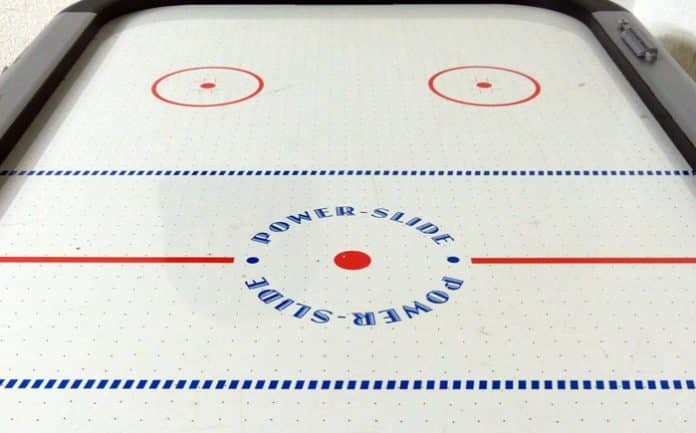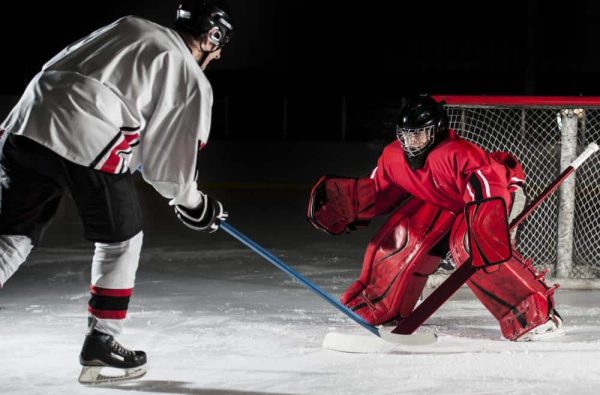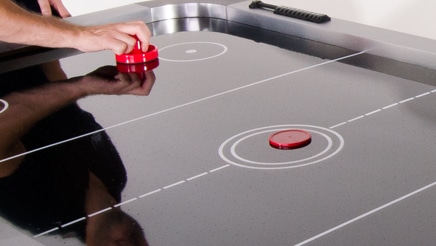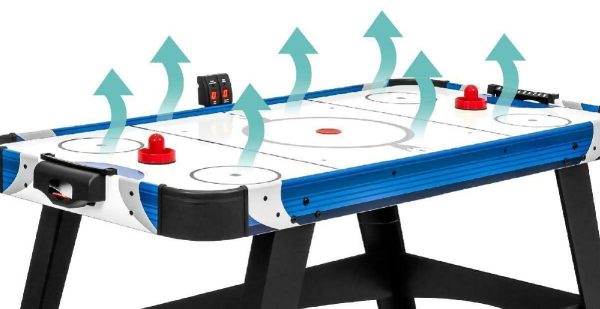Have you ever wondered what sets ice hockey apart from air hockey? While both games involve intense competition and fast-paced action, several vital distinctions make them unique.
In ice hockey, players glide over a frozen rink, carefully maneuvering a puck with sticks, while in air hockey, they hover over a smooth table, using mallets to hit a floating puck.
Each game requires its skills and strategies, resulting in thrilling experiences for players and spectators alike.
Join us as we explore the exciting world of ice hockey and air hockey and uncover the differences that make each game unique.
Review contents
Physical Differences
Playing Surface
One of the significant physical differences between ice hockey and air hockey is the playing surface. In ice hockey, the game is played on a large skating rink made of ice.
The ice surface provides a fast and slick playing area, allowing players to glide smoothly across the ice. On the other hand, air hockey is played on a smaller table with a smooth surface and a cushion of air. This air cushion allows the puck to glide effortlessly, creating a fast-paced and exciting game.
Equipment
Ice hockey and air hockey also differ in terms of equipment. In ice hockey, players wear protective gear, including helmets, shoulder pads, elbow pads, gloves, shin guards, and skates.
This gear is essential to ensure the safety of the players, as ice hockey is a physically demanding sport with a high risk of collisions and falls. In contrast, air hockey requires minimal equipment. Players only need a paddle and a puck, as the game is played on a table without any physical contact between players.
Puck/Paddle
The puck and paddle used in ice and air hockey are also different. The puck is made of hard rubber in ice hockey and weighs around six ounces. It is designed to slide smoothly on the ice and is quite sturdy to withstand the impact of hits and shots.
The paddle ice hockey players use is made of wood or composite materials and has a curved blade for better puck control. In air hockey, the puck is lighter and is made of plastic. It is designed to float on the table’s surface due to the air’s cushion. The paddle in air hockey is usually a small, lightweight plastic mallet.
Movement
The movement of players is another physical difference between ice hockey and air hockey. Ice hockey players skate on ice, using their legs and feet to propel themselves across the rink. They can reach high speeds and maneuver quickly due to the slick surface. On the other hand, air hockey is played while standing, and players move by shuffling their feet and leaning their bodies to control the paddle. The movement in air hockey is more focused on quick hand-eye coordination and precise aiming rather than skating skills.
Gameplay Differences
Objective
Ice hockey aims to score goals by shooting the puck into the opponent’s net. The team that scores the most goals within the designated time wins the game. In air hockey, the objective is the same: to score goals, but instead of a net, players try to shoot the puck into their opponent’s goal without touching any part of their goal or paddle.
Scoring System
In ice hockey, each goal counts as one point, and the team with the most points wins. However, in air hockey, there is no point system. The game is played in rounds, and the player who scores the designated number of goals first wins the round. The overall winner is determined by winning the majority of rounds.
Game Duration
The duration of a game also differs between ice hockey and air hockey. In ice hockey, a standard game consists of three periods, each lasting 20 minutes, with breaks in between.
The total game time can range from approximately one hour to three hours, depending on factors such as stoppages and overtime periods. In air hockey, a game typically consists of a predetermined number of rounds and each round can be played relatively quickly, lasting only a few minutes.
Penalties
Penalties play a significant role in ice hockey, where players can be sent to the penalty box for infractions such as tripping, slashing, or fighting. These penalties result in the offending team playing short-handed for a long time. In contrast, air hockey has no penalties or punitive measures for rule violations, as the game is centered on non-contact and fast-paced action.
Rules and Regulations
Ice Hockey Rules
Ice hockey has an extensive rulebook that governs the game and ensures fair play. Some critical rules in ice hockey include offside, icing, and face-offs.
Offside occurs when an attacking player enters the offensive zone ahead of the puck, and icing is when a player shoots the puck from their defensive zone to beyond the opponent’s goal line without it being touched. Face-offs restart the game after stoppages and occur at the beginning of each period and after goals are scored.
Air Hockey Rules
Air hockey rules are much simpler compared to ice hockey. The main objective is to shoot the puck into the opponent’s goal without fouls or interference.
The rules generally focus on the timing and technique of the game. For instance, the player must serve the puck from behind the centerline and be struck cleanly without any obstruction.
Offsides
Offside is an essential rule in both ice hockey and air hockey, but it is defined differently for each sport. In ice hockey, players are considered offside when they precede the puck into the attacking zone.
This rule ensures that teams do not gain an unfair advantage by cherry-picking or positioning players ahead of the play. In air hockey, offsides occur when a player’s hand or paddle crosses the centerline, resulting in a loss of possession.
Icing
Icing is another rule that is specific to ice hockey. Icing occurs when a player shoots the puck from the side of the center line and crosses the opponent’s goal line without being touched by an opponent.
This rule prevents teams from simply shooting the puck down the ice to relieve pressure and forces them to make strategic plays to maintain possession.
Face-offs
Face-offs are common in ice hockey and air hockey and are used to restart the game after stoppages. In ice hockey, face-offs occur at the beginning of each period, after goals are scored, and during particular stoppages in play.
In air hockey, face-offs happen at the start of each round and after a goal is scored. During a face-off, the referee drops the puck between two opposing players, and they try to gain control of it by using their sticks or paddles.
Player Positioning and Formation
Ice Hockey
In ice hockey, players are divided into three central positions: forwards, defensemen, and goaltenders. Forwards are responsible for scoring goals and creating offensive plays.
Defensemen focus on defending their own goal and preventing the opponents from scoring. Goaltenders are tasked with stopping the puck from entering their team’s net. Typically, a team’s formation consists of three forwards, two defensemen, and a goaltender on the ice at any given time.
Air Hockey
Air hockey, being a two-player game, does not have complex player positioning and formation like ice hockey. Each player stands on one side of the table behind their goal, with their paddle ready to strike the puck.
The simplicity of air hockey allows players to focus solely on their skills and strategies without needing specific positions.
Physical Demands
Strength and Endurance
Ice hockey demands a high level of strength and endurance from its players due to its physicality and fast-paced nature. Players need to be able to skate powerfully for extended periods, engage in body checking, and withstand physical contact.
Additionally, using a stick effectively and shooting the puck forcefully requires upper-body strength. In contrast, air hockey is less physically demanding, relying more on hand-eye coordination and quick reflexes than physical strength.
Speed and Agility
Ice and air hockey require players to possess speed and agility, albeit in different ways. Ice hockey players must be fast and agile on skates to move swiftly across the ice, change directions quickly, and avoid opponents.
On the other hand, air hockey players need quick reflexes to react to the puck’s movements and make precise shots. The speed and agility required in air hockey focus more on hand-eye coordination than physical skating abilities.
Types of Competitions
Ice Hockey Competitions
Ice hockey is widely played at various levels and has several competitions. At the professional level, professional leagues such as the NHL (National Hockey League) in North America and the KHL (Kontinental Hockey League) in Europe showcase the highest level of ice hockey talent.
International competitions, such as the Olympic Games and the IIHF World Championships, allow teams from different countries to compete against each other. Additionally, ice hockey is played at the youth, collegiate, and amateur levels, providing opportunities for players of all ages and skill levels to participate and compete.
Air Hockey Competitions
While not as widespread as ice hockey, air hockey has its share of competition. Professional air hockey tournaments, such as the Air Hockey World Championships, bring together some of the best air hockey players worldwide to compete for the title.
Local and regional air hockey competitions are organized at different skill levels, allowing players to test their skills and compete against opponents of similar abilities.
Popularity and Accessibility
Ice Hockey Popularity
Ice hockey is highly popular in countries where winter sports are prevalent, such as Canada, the United States, Russia, Sweden, and Finland. It has a passionate fan base and a rich history in these countries. The popularity of ice hockey is also evident from the professional leagues, which attract millions of viewers and sell-out arenas. In addition, ice hockey has a strong presence in popular culture and media, further contributing to its popularity.
Ice Hockey Accessibility
The accessibility of ice hockey varies depending on the geographical location. In countries with a colder climate and a strong ice hockey culture, many ice rinks are available for recreational and competitive play. However, in warmer regions or areas without access to ice facilities, the availability of ice hockey may be limited, making it less accessible for those interested in trying or pursuing the sport.
Air Hockey Popularity
While air hockey may not have the same level of popularity as ice hockey, it has gained a significant following in recent years. Many enjoy playing air hockey in arcades, entertainment centers, and even in their homes. The fast-paced nature of air hockey and its accessibility makes it a popular choice for casual players and those looking for a fun and competitive game.
Air Hockey Accessibility
Air hockey is relatively accessible compared to ice hockey, primarily due to the availability of air hockey tables in various recreational facilities. Arcades, family entertainment centers, and sports clubs often have air hockey tables for people to enjoy. This accessibility allows individuals of different ages and skill levels to experience air hockey without needing specialized equipment or facilities.
Historical Background
Ice Hockey Origins
The exact origins of ice hockey are a subject of debate, but the sport is believed to have originated in Canada in the late 19th century. The first recorded organized indoor ice hockey game took place in Montreal in 1875, and the sport quickly gained popularity in Canada. It eventually spread to other cold-weather regions, including the United States and Europe, and became an internationally recognized sport.
Air Hockey Origins
Air hockey, in contrast, is a relatively new invention compared to ice hockey. It was invented in the late 1960s by a trio of engineers: Bob Lemieux, Phil Crossman, and Brad Baldwin.
They created the prototype of air hockey as a variation of ice hockey, intending to bring the speed and excitement of ice hockey to a smaller and more accessible scale. The first commercial air hockey table was introduced in 1972, and the game quickly gained popularity, eventually becoming a popular arcade game.
Strategy and Tactics
Ice Hockey Strategies
Ice hockey strategies involve a combination of offensive and defensive tactics. Teams employ various strategies, such as forechecking, neutral zone traps, and power plays, to gain an advantage over their opponents.
Forechecking is a strategy to pressure the opposing team’s defense and create turnovers. At the same time, the neutral zone trap focuses on slowing down the opponent’s offensive momentum by clogging the middle of the ice. Power plays occur when a team has a numerical advantage due to a penalty, and they aim to capitalize on the extra player by executing effective passing and puck movement.
Air Hockey Strategies
While simpler than ice hockey, air hockey strategies still require skill and quick thinking. Players aim their shots strategically to confuse and defeat their opponent’s defenses.
They may use different techniques, such as bank shots off the side walls or quick shots aimed at the corners of the goal, to outmaneuver their opponent. Good hand-eye coordination and the ability to react quickly to the puck’s movements are crucial in implementing effective strategies in air hockey.
Tactical Differences
One of the main tactical differences between ice hockey and air hockey lies in the games. Ice hockey allows for more individual creativity and improvisation due to the larger teams and the physicality of the sport.
Players often make split-second decisions based on the evolving dynamics of the game. Air hockey, on the other hand, is more about precise technique and finding gaps in the opponent’s defense. Tactical decisions in air hockey revolve around positioning the paddle correctly and executing accurate shots, requiring excellent hand-eye coordination.
Global Influence
International Associations
Ice and air hockey have international associations that govern the sport and promote its development worldwide.
The International Ice Hockey Federation (IIHF) is the global governing body for ice hockey and oversees international competitions such as the Olympics and the World Championships. Air hockey is governed by the United States Air Hockey Association (USAA), which organizes tournaments and maintains official rules and rankings.
Representation in Olympics
Ice hockey has been a part of the Winter Olympics since the early 20th century, representing one of the most prestigious stages for the sport.
The Olympic ice hockey tournament features teams from various nations competing for gold, silver, and bronze medals. In contrast, air hockey is not currently included as an Olympic sport, although there have been discussions and campaigns to advocate for its inclusion in the future.
In conclusion, while ice hockey and air hockey share some similarities as dynamic and fast-paced games, they also have distinct differences in the playing surface, equipment, rules, and gameplay. Ice hockey played on ice with extensive equipment and complex rules and strategies, has a rich historical background, widespread popularity, and global recognition through international competitions and representation in the Olympics.
Air hockey, played on a table with minimal equipment and more straightforward rules, is accessible to a broader audience and offers fast-paced fun without the physical demands of ice hockey. Both sports provide unique experiences and opportunities for players and enthusiasts to showcase their skills and enjoy the thrill of competitive gameplay.




























![Best Outdoor Dartboards [Reviews and Buying Guide 2024] Best Outdoor Dartboards](https://gamersets.com/wp-content/uploads/2022/12/Best-Outdoor-Dartboards-100x70.jpg)

![Best Mini Air Hockey Table [Reviews & Buying Guide 2024] Best mini air hockey table](https://gamersets.com/wp-content/uploads/2022/10/Best-mini-air-hockey-table-100x70.jpg)







